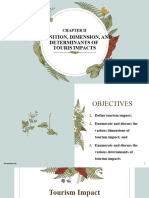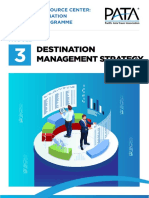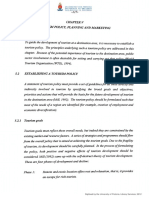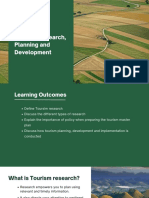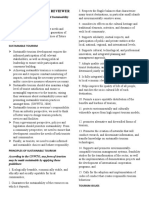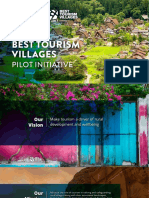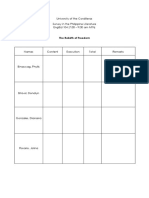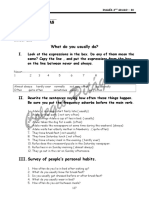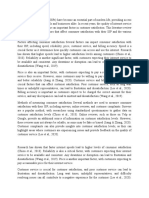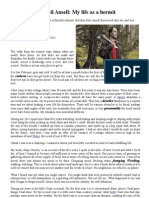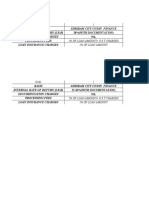Sustainable Midterm
Uploaded by
Julienne DumaelSustainable Midterm
Uploaded by
Julienne DumaelWEEK 7
Destination Management Core Indicators
Tourism Impact Assessment
Tourism impact assessment is important for a number of reasons. First, it forces planners
and developers to foresee what could possibly go wrong and take precautions to prevent Sustainable Tourism Public Policy.
such unfortunate consequences from happening. A sustainable tourism policy should be multi-year and consider environmental, social,
quality, health, and safety issues. It should have clear, timebound goals, and is
developed with the participation of relevant stakeholders.
By assessing the potential impacts, planners and developers would be able to identify
actions that could prevent or mitigate the impacts. They could choose to abort the project,
relocate the project, or take mitigation measures to minimize the adverse impacts. An Sustainable Tourism Management in Tourism Enterprises. Examines planning and
example of a mitigating measure to reduce the impact of noise levels from a new airport is management at the firm level. It assesses the extent to which tourism establishments
locating the airport at a sufficient distance from residential areas. are actively incorporating sustainability principles into their operations.
At the conceptualization stage of a tourism project, it is imperative to take the following Customer Satisfaction.
factors into considerations. Failure to do so may result in legal suits, financial loss, and A crucial component of sustainable destination management because satisfied
image problems. customers result in return visits, multiplied economic value, and more jobs.
1. constitution and existing laws Information and Communication.
2. land use and spatial planning Relates to how destination management organizations (DMO) explore opportunities to
3. zoning laws, zones of tourism value raise tourists’ awareness of sustainability issues and provide marketing advantage
4. regulations on tourism investments, tourism enterprise zones, and tourism enterprises through promotional materials.
5. building code (various permits, standards for various types of structures
6. business registration requirements Economic Value Core Indicators
7. requirement for public consultation
8. foreign equity laws Tourism volume and value.
9. protected area laws Critical to the economic viability of a destination. The level of tourist expenditure is a
10. indigenous people’s right, including their right to ancestral domains reflection of the efficiency of the tourist destination at generating tourism value.
11. gender and development provisions
12. minimum wage laws
13. labor laws Tourism Enterprises performance.
14. environmental laws As indicated by the average length of stay of tourists in terms of nights and occupancy
15. tourism act rates of accommodation facilities, is another core indicator of economic sustainability.
16. critical habitat areas
17. buffer zones. Quantity and quality of employment.
Employment generation is one of the most desired effects of tourism for most
Tourism Impact Assessment Tools governments. Besides the sheer volume of jobs created, the jobs must also be of good
quality. This means that they should be decent work, available year round, offer
Triple Bottom Line Approach. training, and promote gender equity.
Encompasses economic, social, and environmental impacts of tourism. TBL started out as
a philosophy on how companies should incorporate sustainability and their environmental Safety and health.
in planning, but it has evolved into an accounting tool considering not just the financial Measured by the percentage of establishments that underwent fire safety check in the
bottom line, but also environmental and social impact of the company. previous year.
Tourism Carrying Capacity Assessment.
TCCA is used to identify and implement limits to the number of visitors to specific Tourism supply chain.
destinations or attraction. Its limitation lies in the difficulty in quantifying capacities due to Analyzes the integration of tourism businesses with local producers and suppliers of
factors such as technology and type of tourists that come to a destination. tourism-related goods and services. Local procurement helps decrease leakages and
increases the multiplier effect of tourism.
European Tourism Indicator System.
ETIS is an assessment tool for monitoring, managing, and enhancing tourism destination Social and Cultural Impact Core Indicators
sustainability. The System is comprised of a set of indicators, a toolkit, and a dataset. It is
an instrument that can be used by any destination without the need for any specific Community/social impact.
training. It can be used as a guide for decision-making and policy formation. Monitoring how resident satisfaction reacts to increase or decrease in tourist arrivals
can help anticipate problems so they could be addressed immediately.
Gender equality
To be sustainable tourism must be able to provide satisfactory employment to both
men and soon.
Core Indicators of ETIS
Accessibility for persons with disability. EIA is defined by the Department of Environment and the Natural Resources
Social equity in tourism involves providing access to all including people with disabilities Environmental Management Bureau (DENR-EMB) as a “process that involves
(PWD). Accommodations and attractions should make provisions for PWDs. predicting and evaluating the likely impacts of a project (including cumulative
impacts) on the environment during construction, commissioning, operation, and
Protecting and enhancing cultural heritage. abandonment.
Protecting and enhancing cultural heritage, local identity, and assets are a core indicator of
cultural and social impact. Preserving heritage building, music, and festivals helps enhance Economic Viability.
the cultural identity and pride of a place. Viability hinges partly on whether or not the tourist facilities that are provided are able
to satisfy the needs, preferences, and expectations of targeted tourist segments.
Environmental Impact Core Indicator
Assessing Jobs in Tourism.
Reducing transport impact. The quality of jobs may be assessed using the decent work framework established by
Reducing transport’s impact on the environment can be done by shortening distances the International Labor Organization.
between the places of origins of tourists and destinations and travel times, and encouraging
the use of environment friendly tourist transportation. Other Impact Assessment Frameworks.
The World Tourism Organization enumerated ten core indicators of sustainable
Tourism Impact on climate change. tourism development.
Climate change mitigation and adaptation strategies need to be considered in tourism 1. site protection
because many businesses are located in vulnerable areas. 2. stress
3. use intensity
4. social impact
Solid waste management. 5. development control
This could be done through economic incentives, recycling, composting, and reuse 6. waste management
programs. 7. planning process
8. critical ecosystems
Sewage treatment. 9. consumer satisfaction
Effluent can cause environmental and health problems and create a negative image of the 10. local satisfaction
destination if not properly treated.
Economic Indicators
Water management. 1. Tourism revenues
This issue must be addressed especially in places where there is a scant water supply, and 2. average tourist expenditure
where tourism draws water away from the local residents. 3. taxes from tourism
4. number of registered tourism-related business
5. inflation/price index in tourist areas
Energy use.
Energy use has implications on climate change and economic sustainability. Sustainable Environmental Indicators
tourism development involves monitoring energy usage and conservation facilities.
1. water quality index
Landscape and biodiversity protection. 2. air quality index
This can be measured by taking the percentage of the destination’s area that is designated 3. infrastructure to manage and minimize solid and liquid wastes
for protection, expressed in square kilometers. 4. percent of population exposed to pollution
5. amount of water consumed and percentage of leakage
Light and noise management.
Excessive noise and light impact negatively places like stargazing areas, turtle nesting Socio-cultural Indicators
sites, and mountain retreats. Policies for lighting and noise levels need to be considered for
tourism development. 1. poverty incidence in tourist areas
2. extent of local linkages
3. extent of local employment
Bathing water quality. 4. incidence of prostitution
Ensuring the quality and safety of water bodies is important for their tourism appeal. 5. number of sexual harassment cases
Bathing water may be indicated by the level of contamination per 100 mL.
Sustainable Livelihood Approach. Institutional Indicators
Analyzes the impact of tourism development on a community in terms of its contribution 1. number of sites with sustainable master plans
to building capabilities, assets (natural, economic or financial, human, and social capital), 2. presence of indicators and adherence to the same
and activities required for a means of living. 3. presence of tourism master plans which incorporate sustainable principles
4. presence of land use and zoning plans
Philippine Environmental Impact Assessment System. 5. presence of protected areas management system
WEEK 8 Rights of the workers and entrepreneurs in the tourism industry This article talks about
the rights and duties of tourism workers and entrepreneurs, including multinational
The Global Code of Ethics companies. Tourism workers must enjoy the fundamental rights guaranteed by their
The UNWTO adopted the Global Code of Ethics for Tourism in 1999, which is a States of origin and host countries, taking note of the specific constraints brought
comprehensive set of principles designed to guide the actions of government, the private about by the characteristics of tourism, such as seasonality, tourism’s global
sector, communities, and tourists alike in order to maximize tourism’s benefits and dimension, and the flexibility often required of them by the nature of their work.
minimize its costs on destinations.
Article 10:
Article 1: Implementing of the principle of the Global Code of Ethics for Tourism This article
Tourism’s contribution to mutual understanding and respect between peoples and societies discusses how the Code should be implemented. This involves cooperation between
Article 1 underscores the necessity of ethical values, tolerance, and respect for diversity, as the public and private stakeholders in tourism development, the recognition of the role
the foundation for responsible tourism. It advocates mutual respect for each other’s of international institutions, particularly the WTO, and non-governmental
practices and customs by tourists and host communities. organizations involved in tourism promotion and development protection of human
rights, environment or health; and for the stakeholders to refer any disputes concerning
Article 2: the application or interpretation of the Global Code of Ethics for Tourism to the World
Tourism as a vehicle for individual and collective fulfillment Article 2 recognizes the value Committee on Tourism Ethics.
of tourism for self-education, mutual tolerance, and learning about human and cultural
diversity. As such, travel for religion, health, education, and cultural or linguistic Social Responsibility
exchanges are encouraged, as well as the inclusion into educational curricula value of Tourism establishments must also observe their social responsibilities. They should
tourism. also avoid undertaking activities of host communities. They should be careful not to
intrude sacred sites and commercialize culturally sensitive events like weddings and
Article 3: funerals.
Tourism, a factor of sustainable development Article 3 stresses the role of all stakeholders
in sustainable tourism development and the prioritization of forms of tourism development Electricity
that help conserve the environment. - Renewable energy systems such as solar water heaters, solar pumps, windmills,
photovoltaic systems to power radios, lights computers, and other low wattage
Article 4: appliances.
Tourism, a user of the cultural heritage of mankind and contributor to its enhancement This - Insulation for roofs, ceilings, hot water items (e.g., pipes and geysers), and cooling
article underscores the need to craft policies and activities that will preserve artistic, devices (e.g., freezers and ice cream machines)
archaeological, historical, and cultural sites for the benefit of present and future
generations, including the financial resources derived from visits to such sites for their Refrigeration
upkeep, safeguard, development, embellishment, and the promotion of traditional crafts - Set fridge and freezer thermostats to the appropriate temperature for the type of food
and folklore. and the storage period. Set the fridge at between 2.2 and 4.4 C, and the freezer at
between -17.8 and -15 C. Raising the thermostat by 1 C reduces energy costs by 3%
Article 5: for freezers and 6% for refrigerators.
Tourism, a beneficial activity for host countries and communities Article 5 highlights the
importance of enabling local populations to share equitably in the benefits of tourism they Cooking
generate, especially in terms of direct and indirect jobs resulting from them. - Cook with natural gas rather than electricity to save energy - Use microwave to cook
smaller items of food; it uses around 66 percent electricity to heat food than electric
Article 6: hobs.
Obligations of stakeholders in tourism development Article 6 discusses the responsibilities
of tourism professionals, public authorities, and the media. On the part of tourism
professionals, they must provide objective and honest information to tourists about the Dishwashing
destinations, contractual clauses involved in the provision of their services, and financial - Purchase low water and energy-use dishwashers
compensation payable by them in case of unilateral breach of contract. - Operate them only when full
Article 7: Laundry
Right to Tourism This article emphasizes the right to tourism for all peoples which should - Dry linen outside in good weather
be promoted. This universal right must be regarded as the corollary of the right to rest and - Warm wash is more efficient than a hot wash, and cold water is suitable if an
leisure, including reasonable limitation of working hours and periodic holidays with pay, enzymatic detergent is used.
as guaranteed by Article 24 of the Universal Declaration of Human Rights and Article 7.d
of the International Covenant on Economic, Social and Cultural Right. Offices
- Personal computers use not 100 W when operating. Switch off office equipment
Article 8: when not needed.
Liberty of Tourist Movement Article 8 discusses the rights of tourists. According to the - Use energy-saving features on computers, photocopiers, and printers (e.g., sleep
article, people should have the liberty to travel within their countries and to other countries mode)
in accordance with Article 13 of the Universal Declaration of Human Rights subject, to
international and national laws. Lighting
- Compact fluorescent lights ten times as long and use 20% of the energy consumption
Article 9:
bulbs. These three types should be considered with different weights assigned in different
- Low-energy light bulbs produce about seven times of light for the same wattage. destinations. The differences are determined by the type of the place, the type(s) of
tourism present, and the tourism/environment interface. The characteristics of the
Transport place provide the foundation for the development of tourism. These refer to local
- Use lead free gasoline for tourist vehicles resources, the vulnerability of local natural ecosystem, population size, economic
- Do not make unnecessary trips Waste reduction should be a primary concern for tourism structure, culture and local heritage. These characteristics determine the place’s
establishments. resilience to pressures from tourism.
Kitchens Institutional Tools to Implement Tourism Carrying Capacity
- Purchase fridges and freezers without ozone-depleting CFCs (TCC)
- Order and prepare food in relation to guest and staff requirements to minimize waste.
For Nature Protection.
Laundry and Housekeeping 1. Natura 2000 covers 18% of the European Union’s land area. Natura 2000 is a
- Buy concentrated detergent in bulk as they use less packaging. network of nature preserves. The network encompasses lands that have threatened
- Purchase biodegradable products. landscapes and endangered species. Natura 2000 protects mixed forests in Romania,
heathlands in Germany, bogs in Sweden, and desert-like vegetation in Spain, among
Office other landscapes and marine areas.
- Reduce paper wastes by using email or central notice whiteboards. 2. Habitat Directive is a European Union directive adopted in 1992 in response to the
- Proofread documents on the computer before printing. 1982 Berne Convention on the Conservation of European Wildlife and Natural
Habitats, or Berne Convention. Habitat Directive protects over 1000 animals and plant
Outside the buildings species and over 200 habitat types.
—garden and wildlife areas 3. The International Council of Museum (ICOM) Red List classifies endangered
- Use garden trimmings, lawn clippings, and pruning to create mulch for flowerbeds which categories of archaeological objects and works of art in the most vulnerable countries
can help reduce water losses from evaporation. to prevent the sale or illegal export of such objects.
- Use compost heap or worm farm to create compost from material like cardboard and 4. The International Union for the Conservation of Nature IUCN Red List of
animal manure. Threatened Species, established in 1964, is an inventory of thousands of threatened
and endangered species and subspecies.
Workshop Environmental Impact Assessment is a tool for evaluating the potential impacts of
- Return waste oil to nearest supplier tourism in a given area. EIA is a process that involves predicting and evaluating the
- Do not contaminate the soil with oil and petrol; place sawdust, or an equivalent, over likely impacts of a project on the environment during construction, commissioning,
nonabsorbent floors in the workshop and maintenance area, and dispose of it in an operation, and abandonment.
environmentally friendly manner.
Management Tools for Implementing TCC
Land filling -Zoning is applied mainly in protected areas. Zone A refers to the most valuable and
- Enclose landfills to minimize access by scavengers vulnerable zone; entry is limited to authorized scientific teams. Zone B is for highly
- Burn methane gas to reduce the likelihood of explosion. sensitive zone; escorted visits in small groups are permitted. Zone C is zones of
considerable natural interest; some traditional tourism activities could be permitted,
Where incineration is necessary but car access is limited. Zone D is for areas with mild development and buffer; they
- Ensure that the temperature of the waste burned is hot enough to maximize combustion are compatible with tourism and visitor facilities, car access, parking, and compatible
and reduce the amount of ash produced. activities are allowed.
- Use filters to trap poisonous fumes from entering the atmosphere, and regularly replace
them Site Management Techniques
WEEK 9 1. facility design
2. use of vegetation barriers
The Importance of Managing Visitors 3. site hardening
-There are a number of reasons why it is important to manage visitors’ actions and 4. closure of facilities
activities at parks, hotels, restaurants, resorts, and many other tourism-related 5. rationing such allocation, such as through reservations, queuing, lotteries, eligibility
establishments. These are to protect the tourists and others around them, enable them to requirements and pricing.
derive, the utmost satisfaction from the tourism experience, discover facts that make them
better appreciate the attractions, protect the property or area they are in, maintain the Management Options to Minimizing Visitor Impacts
quality of cleanliness at hotels, be able to save energy, prevent animals from losing their
wild traits, among others. 1. seasonal or temporal limits on use: limiting visiting times and restricting car
Carrying Capacity Carrying parking, accommodation facilities, or public transport.
-capacity is the maximum number of people that may visit a tourist destination at the same 2. regulating group size and providing guided tours that allow for more control;
time, without causing destruction of the physical, economic, and socio-cultural 3. zoning: closing certain areas to visitors or reducing visits to ecologically important
environment and an unacceptable decrease in the quality of visitors’ satisfaction. There are areas;
three types of carrying capacityenvironmental, physical, and perceptual or psychological. 4. increasing entrance fees at peak periods or to popular areas;
5.providing garbage bins to discourage littering. c. zoning.
Monitoring Impacts The main tactics for use-rationing are
-Managing an attraction requires monitoring of visitor numbers, set indicators, visitor (1) reservation systems,
behavior, etc. The purpose of monitoring is to determine whether a problem is developing (2) lotteries,
or whether a problem is developing or whether desired standards are being complied with. (3) first come, first served or queuing,
Monitoring provides the basis for management interventions. Situations that demand (4) pricing, and
corrective measures are deterioration and when development is below standard. During (5) merit. A pricing system may “filter out” those who are unable or unwilling to pay.
deterioration, conditions are getting worse but still within the minimum acceptable A merit system requires potential visitors to “earn” the right to a permit by
standard. At this level, measures could be taken, but such should not substantially restrict demonstrating knowledge or skill.
access to the attraction. When development is out of the minimum standard, the
appropriate action would be to restrict or modify recreational use to restore and maintain Common applications of rules and regulations in tourism and outdoor recreation
acceptable standards. include
(1) group size limits,
Criteria for Decision-making (2) assigned campsites or travel itineraries,
1. does the strategy adequately address the root cause of the impact? (3) area closures,
2. how effective is it in resolving problems? (4) length of stay limitations,
3. will it not create new problems? (5) restrictions and prohibitions on high impact activities and behaviors.
4. is it subtle or obtrusive in terms of visitors being aware that they are being managed?
5. is it direct or indirect in how it impacts or influences visitor behavior Zoning entails assigning or restricting certain activities to specific areas or restricting
6. does it preserve the visitors’ freedom of choice? activities from area.
7. how many visitors will be affected by it?
8. does it affect an activity that is very important to some visitors? Site Design and Sustainable Infrastructure Development
9. are visitors likely to resist it? -Views, natural hazards, traditional activities, transportation access for staff and
10. how much will it cost? tourists, climate, slope, access to natural and cultural features, energy and utilities,
proximity to relevant goods and services, and staff availability and housing are some
Determinants of Tourist Behavior of the critical factors that need to be considered in site planning.
-Tourist behavior is also influenced by whether tourism is land-based or ship-based and by
site-specific characteristics. New locations attract new tourist activities which produce Sustainable Transportation and Travel Patterns
cumulative impacts as tourism destinations in Antartic are established and consolidated. -Sustainable transportation solutions include improved public transit access, biking
Cumulative impacts occur at sites where tourism is carried out partially, such as by trails, thoughtful signage, and park trolley systems.
governmental or non-governmental organizations on the continent, or where tourism is the
only activity that takes place regularly. Law Enforcement
-Law enforcement can be categorized into soft and hard. Soft enforcement includes
WEEK 10 facility design and signage or the visibility of a security officer. Hard enforcement
includes issuance of citations, fines, and arrests.
Communication and Habitual Behavior
-Highly experienced travellers who have developed certain habits are not readily Economic and Marketing Tools
influenced by persuasive communication. For this type of travellers, a more complex -Differential pricing can be used to prevent negative impacts at certain locations.
approach will be needed, entailing the provision of incentives, disincentives, rewards, Charging higher prices during peak season may reduce crowding. Pricing must also
punishment, or even direct interventions like patrolling and enforcing policy violations. consider equity issues as disadvantaged groups or local stakeholders need to have
Community based campaign of education could also be considered. continued access to tourist sites such as national parks. Private reserves may use higher
prices to position their property as premium tourist sites.
Tourism and Visitor Management Tools
Marketing and Communication
1. regulatory and planning tools -Marketing and communications can also be employed to promote the benefits of
2. site design and sustainable infrastructure development going to a tourist site. Facility signage, website, newsletters, and brochures are some
3. sustainable transportation and travel patterns of the most common communication tools directed to visitors or tourists.
4. law enforcement
5. economic and marketing tools Use of Technologies
6. marketing and communications -Satellite phones, GPS-enabled smart phones, and Wi-Fi in park campgrounds
7. use of technologies facilitate travel but also potentially degrade the “restorative properties of nature,
8. education and interpretation disrupt social bonding opportunities, and restrict physical activity benefits which are
associated with to visit parks.
Regulatory and Planning Tools Education and Interpretation
-Education and interpretation programmers facilitate the appreciation of nature and
This class of direct management tools includes unique cultures and help develop positive attitudes towards conservation. The broader
a. use rationing process of education is concerned with the development of the learners’ personal
b. rules and regulations
knowledge and understandings that involve their growth of character, moral, and social Optimized site potential. Proper site selection, orientation, and
qualities. landscaping; and consideration of the reuse or rehabilitation of existing
buildings and future expansion.
WEEK 11
Optimized energy use. To reduce energy load, increase efficiency and maximize the
Definition of Mitigation use of renewable energy sources to significantly reduce dependence on fossil fuel-
derived energy.
Mitigation is the implementation of measures designed to reduce the undesirable effects of a proposed
action on the environment. Protection and conservation of water. To use water efficiently, reduce, reuse, or
recycle water for on-site use.
Mitigation measures: (1) prevention and control measures, (2) compensatory measures; and (3)
remediation measures. Optimized building space and material use. The integrated and intelligent use of
materials to maximize their value, prevent upstream pollution, and conserve
The purpose of prevention and control measures is to fully or partially prevent an impact or risk by resources; use and reuse materials in the most productive and sustainable way over
changing the means or technique, changing the site, or specifying operating practices. the building’s life cycle.
The aim of compensatory measures is to offset the adverse impacts in one area with improvements in Enhanced indoor environmental quality (IEQ). Enhanced IEQ involves maximized
another area. day lighting, appropriate ventilation and moisture control, optimized acoustic
The goal of remediation measures is to repair or restore the environment after damage is done. performance, avoiding materials with high-VOC emissions, and occupant control over
lighting and temperature system.
Minimizing Carbon Footprint Optimized operational and maintenance practices. Specifying materials and systems that simplify and
reduce maintenance requirements; require less water, energy, and toxic chemicals and cleaners to maintain;
and are cost-effective and reduce life-cycle costs
The tourism industry contributes about 5% of global carbon emissions. Half of this footprint is caused
by the aviation sector. A number of alternative fuels are available. Alternative fuels emit less carbon
because they are cleaner burning than diesel or gasoline. Alternative fuels that are being used in
transportation include biodiesel, ethanol, propane, compressed natural gas, and hydrogen.
Biodiesel is produced from vegetable oils and animal fats. Ethanol is made from plants. Gasoline
can be blended between 10% and 85% ethanol. Propane or liquefied petroleum gas (LPG) is a by-
product of natural gas processing and crude oil refining. Compressed Natural Gas (CNG) is made up
mainly of methane. Hydrogen can produce electricity through the chemical reaction between oxygen
and hydrogen.
Air Pollution Mitigation
Vehicles emit air pollutants. Two ways to mitigate this problem are (1) to set as far back facilities
away from the road, and (2) to plant trees which will serve as buffer between the tourism facilities and
the road. The trees will not block away air pollution but noise.
Wastewater-saving Technologies
Tourism is a water intensive industry, particularly in the context of golf courses and luxury hotels that
have bathtubs installed as standard hotel amenities. There are number of technologies that help conserve
this precious resource. Water-free urinals, water recycling plants to produce clean water from kitchen
sewage, low-flush toilets, two-level flush toilets, spring action faucets, electronic sensor activated
flush, low flow showers, rainwater catchments, and composting toilets.
Solid waste Reduction
The first step in waste is to prevent its production in the first place. Waste prevention could be in the
form of sorting/cycling of glass, aluminum, paper, and plastics from guest rooms; providing bulk
dispensers for soap, shampoo, and lotion; returning laundered clothes to guests in reusable clothes,
bags/baskets; offering rarely used items such as sewing kits by request only; instructing housekeeping
not to replace half-used rolls of toilet paper/tissue boxes, and leave replacements for guests to use if
required.
Sustainable Building Design
You might also like
- Course Title/Code Non Institutional Correction/ Ca2100% (2)Course Title/Code Non Institutional Correction/ Ca24 pages
- S. L. MacGregor Mathers, Aleister Crowley - The Goetia - The Lesser Key of Solomon The King - Clavicula Salomonis Regis PDF100% (23)S. L. MacGregor Mathers, Aleister Crowley - The Goetia - The Lesser Key of Solomon The King - Clavicula Salomonis Regis PDF158 pages
- Definition, Dimensions Determinants of Tourism Impacts: Learning OutcomeNo ratings yetDefinition, Dimensions Determinants of Tourism Impacts: Learning Outcome17 pages
- Destination Planning Concepts: Kavya Vinay I 08 I M2 I GectNo ratings yetDestination Planning Concepts: Kavya Vinay I 08 I M2 I Gect10 pages
- Module 3 - Destination Management StrategyNo ratings yetModule 3 - Destination Management Strategy21 pages
- 9781800377486-b-9781800377486.visitor.managementNo ratings yet9781800377486-b-9781800377486.visitor.management4 pages
- Sustainable AND Responsible Development: (Updated February 2015)No ratings yetSustainable AND Responsible Development: (Updated February 2015)20 pages
- Role of Public and Private Sector in Tourism: Presented By: Ashish Kaushik100% (2)Role of Public and Private Sector in Tourism: Presented By: Ashish Kaushik32 pages
- Determinants of Tourism Impacts PPT Hello 1No ratings yetDeterminants of Tourism Impacts PPT Hello 120 pages
- Overtourism_ the Role of Effective Destination Management -- Helene Von Magius Møgelhøj -- Business Expert Press, [S_l_], 2021No ratings yetOvertourism_ the Role of Effective Destination Management -- Helene Von Magius Møgelhøj -- Business Expert Press, [S_l_], 2021131 pages
- Prelim - Hyplex Module Micro Perspective of Tourism and HospitalityNo ratings yetPrelim - Hyplex Module Micro Perspective of Tourism and Hospitality14 pages
- The Role of The Public Sector in Developing Tourism Product Strategies For Tourism DestinationsNo ratings yetThe Role of The Public Sector in Developing Tourism Product Strategies For Tourism Destinations14 pages
- Conjunctions Prepositions and Interjections Language Review Game Presenta 20240920 211237 0000 (1)No ratings yetConjunctions Prepositions and Interjections Language Review Game Presenta 20240920 211237 0000 (1)21 pages
- Research Paper On Social Impacts of MICE Tourism in IndiaNo ratings yetResearch Paper On Social Impacts of MICE Tourism in India13 pages
- Planning & MGT of Smart Destination-Chapter 1 - 230619 - 121526No ratings yetPlanning & MGT of Smart Destination-Chapter 1 - 230619 - 12152640 pages
- Sustainable Tourism Reviewer: SustainabilityNo ratings yetSustainable Tourism Reviewer: Sustainability5 pages
- 1-Basic Concepts in Tourism Planning and DevelopmentNo ratings yet1-Basic Concepts in Tourism Planning and Development40 pages
- Group 4. Tourism Characteristics and Their Planning ImplicationsNo ratings yetGroup 4. Tourism Characteristics and Their Planning Implications12 pages
- Tourism in Montene Gro: A Destination Management PerspectiveNo ratings yetTourism in Montene Gro: A Destination Management Perspective16 pages
- Assessment of Tourism Impacts: ObjectivesNo ratings yetAssessment of Tourism Impacts: Objectives6 pages
- Tourism and Travel Management Formatted PaperNo ratings yetTourism and Travel Management Formatted Paper10 pages
- Unit 1 The Evolution of Tourism Planning: 1.0 ObjectivesNo ratings yetUnit 1 The Evolution of Tourism Planning: 1.0 Objectives8 pages
- The Assessment of Carrying Capacity A Crucial ToolNo ratings yetThe Assessment of Carrying Capacity A Crucial Tool9 pages
- Tourism Brand and Strategy For Sustainable Tourism Development of Bongabon, Nueva EcijaNo ratings yetTourism Brand and Strategy For Sustainable Tourism Development of Bongabon, Nueva Ecija4 pages
- JumpStart Kindergarten (1997) - JumpStart Wiki - FandomNo ratings yetJumpStart Kindergarten (1997) - JumpStart Wiki - Fandom10 pages
- 12-FD-2023-359967 5 Gallon MAI DUBAI DECEMBER 1-2-3-4-5-6-7-8No ratings yet12-FD-2023-359967 5 Gallon MAI DUBAI DECEMBER 1-2-3-4-5-6-7-82 pages
- Download full Ecological Risk Assessment Second Edition Glenn W. Suter Ii ebook all chapters100% (8)Download full Ecological Risk Assessment Second Edition Glenn W. Suter Ii ebook all chapters75 pages
- Complaints Against Police and Public Officials: Chapter ContentsNo ratings yetComplaints Against Police and Public Officials: Chapter Contents15 pages
- Tutorial Vtun + Bridge - Voip PMF: ServidorNo ratings yetTutorial Vtun + Bridge - Voip PMF: Servidor8 pages
- LO2. Maintain Appropriate Kitchen Tools, Equipment, and ParaphernaliaNo ratings yetLO2. Maintain Appropriate Kitchen Tools, Equipment, and Paraphernalia3 pages
- What Do You Usually Do?: Curso: Inglés Grado: 2doNo ratings yetWhat Do You Usually Do?: Curso: Inglés Grado: 2do2 pages
- Georges Teyssot 2008 Aldo Van Eyck's ThresholdNo ratings yetGeorges Teyssot 2008 Aldo Van Eyck's Threshold17 pages
- My Life As A Hermit - Newspaper Article 1 QUESTIONNo ratings yetMy Life As A Hermit - Newspaper Article 1 QUESTION3 pages
- [Ebooks PDF] download Introduction to the Speechmaking Process 15th Edition Diana K. Leonard & Raymond S. Ross full chapters100% (1)[Ebooks PDF] download Introduction to the Speechmaking Process 15th Edition Diana K. Leonard & Raymond S. Ross full chapters40 pages
- Get (Ebook) The Routledge Research Companion to Nineteenth-Century British Literature and Science by John Holmes (editor), Sharon Ruston (editor) ISBN 9781472429872, 1472429877 free all chapters100% (6)Get (Ebook) The Routledge Research Companion to Nineteenth-Century British Literature and Science by John Holmes (editor), Sharon Ruston (editor) ISBN 9781472429872, 1472429877 free all chapters81 pages
- AntibacterialactivityofRhoeodiscolorHance JournalNo ratings yetAntibacterialactivityofRhoeodiscolorHance Journal5 pages
- Course Title/Code Non Institutional Correction/ Ca2Course Title/Code Non Institutional Correction/ Ca2
- S. L. MacGregor Mathers, Aleister Crowley - The Goetia - The Lesser Key of Solomon The King - Clavicula Salomonis Regis PDFS. L. MacGregor Mathers, Aleister Crowley - The Goetia - The Lesser Key of Solomon The King - Clavicula Salomonis Regis PDF
- Definition, Dimensions Determinants of Tourism Impacts: Learning OutcomeDefinition, Dimensions Determinants of Tourism Impacts: Learning Outcome
- Destination Planning Concepts: Kavya Vinay I 08 I M2 I GectDestination Planning Concepts: Kavya Vinay I 08 I M2 I Gect
- Sustainable AND Responsible Development: (Updated February 2015)Sustainable AND Responsible Development: (Updated February 2015)
- Role of Public and Private Sector in Tourism: Presented By: Ashish KaushikRole of Public and Private Sector in Tourism: Presented By: Ashish Kaushik
- Overtourism_ the Role of Effective Destination Management -- Helene Von Magius Møgelhøj -- Business Expert Press, [S_l_], 2021Overtourism_ the Role of Effective Destination Management -- Helene Von Magius Møgelhøj -- Business Expert Press, [S_l_], 2021
- Prelim - Hyplex Module Micro Perspective of Tourism and HospitalityPrelim - Hyplex Module Micro Perspective of Tourism and Hospitality
- The Role of The Public Sector in Developing Tourism Product Strategies For Tourism DestinationsThe Role of The Public Sector in Developing Tourism Product Strategies For Tourism Destinations
- Conjunctions Prepositions and Interjections Language Review Game Presenta 20240920 211237 0000 (1)Conjunctions Prepositions and Interjections Language Review Game Presenta 20240920 211237 0000 (1)
- Research Paper On Social Impacts of MICE Tourism in IndiaResearch Paper On Social Impacts of MICE Tourism in India
- Planning & MGT of Smart Destination-Chapter 1 - 230619 - 121526Planning & MGT of Smart Destination-Chapter 1 - 230619 - 121526
- 1-Basic Concepts in Tourism Planning and Development1-Basic Concepts in Tourism Planning and Development
- Group 4. Tourism Characteristics and Their Planning ImplicationsGroup 4. Tourism Characteristics and Their Planning Implications
- Tourism in Montene Gro: A Destination Management PerspectiveTourism in Montene Gro: A Destination Management Perspective
- Unit 1 The Evolution of Tourism Planning: 1.0 ObjectivesUnit 1 The Evolution of Tourism Planning: 1.0 Objectives
- The Assessment of Carrying Capacity A Crucial ToolThe Assessment of Carrying Capacity A Crucial Tool
- Tourism Brand and Strategy For Sustainable Tourism Development of Bongabon, Nueva EcijaTourism Brand and Strategy For Sustainable Tourism Development of Bongabon, Nueva Ecija
- JumpStart Kindergarten (1997) - JumpStart Wiki - FandomJumpStart Kindergarten (1997) - JumpStart Wiki - Fandom
- 12-FD-2023-359967 5 Gallon MAI DUBAI DECEMBER 1-2-3-4-5-6-7-812-FD-2023-359967 5 Gallon MAI DUBAI DECEMBER 1-2-3-4-5-6-7-8
- Download full Ecological Risk Assessment Second Edition Glenn W. Suter Ii ebook all chaptersDownload full Ecological Risk Assessment Second Edition Glenn W. Suter Ii ebook all chapters
- Complaints Against Police and Public Officials: Chapter ContentsComplaints Against Police and Public Officials: Chapter Contents
- LO2. Maintain Appropriate Kitchen Tools, Equipment, and ParaphernaliaLO2. Maintain Appropriate Kitchen Tools, Equipment, and Paraphernalia
- My Life As A Hermit - Newspaper Article 1 QUESTIONMy Life As A Hermit - Newspaper Article 1 QUESTION
- [Ebooks PDF] download Introduction to the Speechmaking Process 15th Edition Diana K. Leonard & Raymond S. Ross full chapters[Ebooks PDF] download Introduction to the Speechmaking Process 15th Edition Diana K. Leonard & Raymond S. Ross full chapters
- Get (Ebook) The Routledge Research Companion to Nineteenth-Century British Literature and Science by John Holmes (editor), Sharon Ruston (editor) ISBN 9781472429872, 1472429877 free all chaptersGet (Ebook) The Routledge Research Companion to Nineteenth-Century British Literature and Science by John Holmes (editor), Sharon Ruston (editor) ISBN 9781472429872, 1472429877 free all chapters









